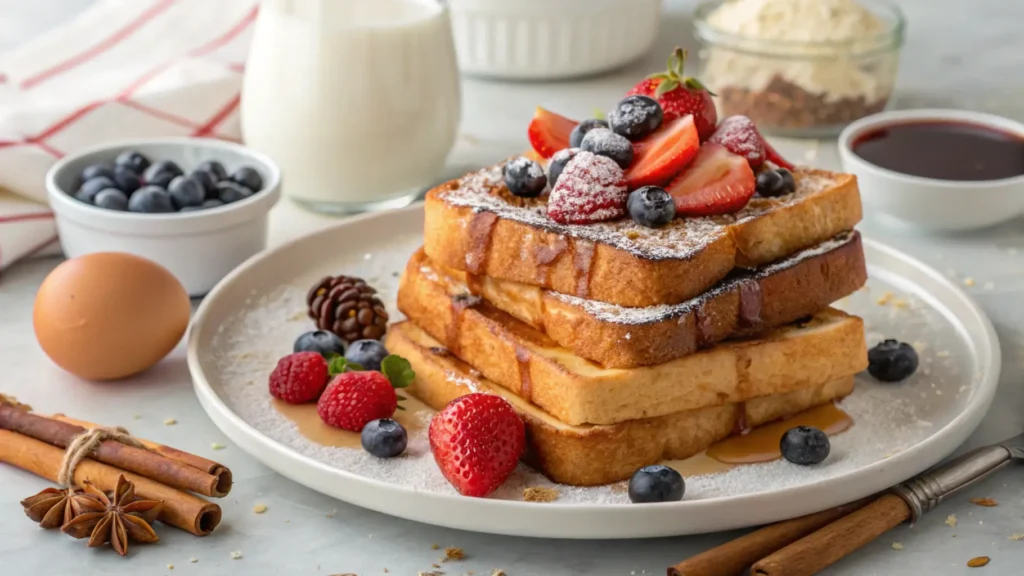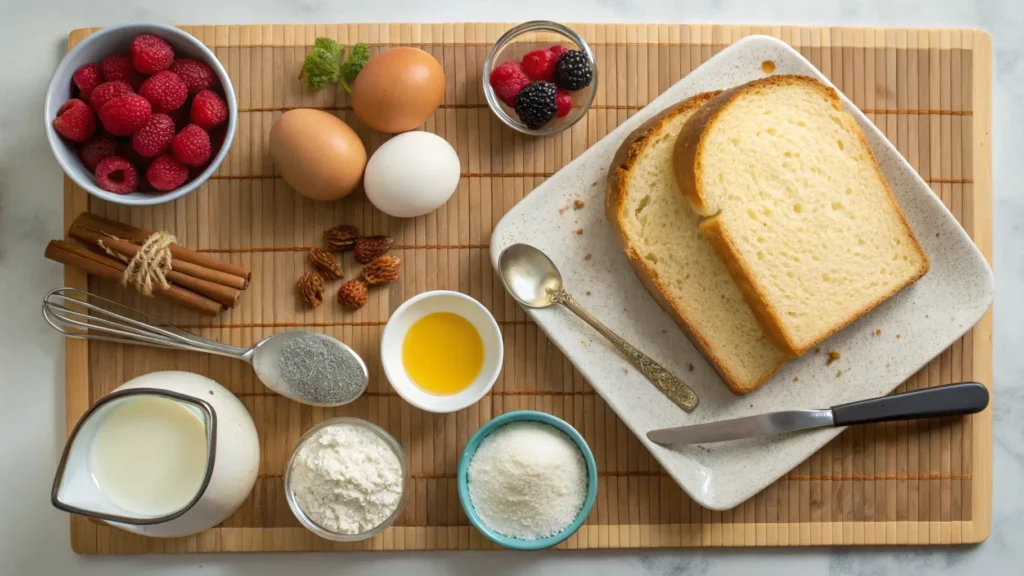Brioche French toast is the perfect blend of buttery brioche and the crisp, golden texture of classic French toast. Additionally, its soft crumb absorbs the egg custard, creating a melt-in-your-mouth bite. Moreover, it can be topped with syrup, fresh fruits, or whipped cream, making it an indulgent start to any day. As a result, this dish not only satisfies your cravings but also elevates your breakfast experience. Whether you’re serving it on a special occasion or as a weekend treat, brioche French toast is always a crowd-pleaser.
For a unique and healthier option, consider trying Cottage Cheese Pancakes. Packed with protein and creamy goodness, they offer a delightful twist to traditional breakfast recipes.

History and Origins of Brioche French Toast
French toast originated as “pain perdu,” or “lost bread,” a way to use stale bread and reduce waste. Over time, different cultures embraced it, adding unique ingredients. For example, in France, it was made with eggs and milk, while in America, it became a popular breakfast with syrup and fruit. Today, it’s enjoyed worldwide in various forms.
Brioche French toast brings a luxurious twist. Made with brioche, a buttery 17th-century bread from French aristocracy, it transforms the dish into a rich and indulgent breakfast staple.
For something different, consider the crispy and playful Bubble Waffle, a delightful addition to any breakfast table!
Why Choose Brioche for French Toast?
Brioche transforms French toast into a rich and indulgent dish. Its buttery flavor and soft, airy texture absorb custard beautifully, creating golden-crisp edges with a tender, custardy interior. Thanks to its high butter and egg content, brioche delivers a luxurious melt-in-your-mouth experience that sets it apart from other breads.
Whether served with syrup, fruit, or a dusting of powdered sugar, brioche French toast is a versatile and satisfying breakfast choice. For another easy and delicious treat, try this One-Bowl Chocolate Chip Banana Bread.
Essential Ingredients for Brioche French Toast
To make the perfect version of this dish, you’ll need just a few key ingredients. Here’s a breakdown of the essentials:
- Brioche bread: This sweet, buttery bread is the foundation of your dish. Opt for fresh, thick slices for the best texture.
- Eggs: Eggs create the rich custard that soaks into the bread. They bind the ingredients together and help achieve that crispy outer layer.
- Milk or cream: Milk gives the custard a smooth consistency, but for extra richness, you can substitute part of the milk with heavy cream.
- Vanilla extract: A small amount of vanilla adds depth of flavor, complementing the sweetness of the brioche.
- Cinnamon or nutmeg: These spices infuse the dish with warmth, enhancing the flavor of the egg custard.
- Butter or oil: For frying the French toast to golden perfection, butter imparts a delicious flavor, while oil prevents burning.
- Sugar: A touch of sugar helps caramelize the bread as it cooks, contributing to a lovely golden crust.
With these simple ingredients, you can create an extraordinary dish of brioche French toast that feels indulgent without requiring a long list of complex components.

Step-by-Step Recipe for Perfect Brioche French Toast
Making brioche French toast at home is simple and rewarding. Follow these steps to create a dish that will impress everyone at your breakfast table:
- Prepare the Custard Mixture
In a large bowl, whisk together eggs, milk (or cream), vanilla extract, cinnamon, and a pinch of salt. The mixture should be smooth and well-combined. - Slice the Brioche
Cut your brioche into thick slices, approximately 1 to 1.5 inches thick. This allows the bread to soak up enough custard without falling apart. - Soak the Brioche
Dip each slice of brioche into the custard mixture, ensuring both sides are fully coated. Let the slices sit for a few seconds to absorb the mixture, but don’t let them soak too long or they might get soggy. - Cook the French Toast
Heat a pan or griddle over medium heat and add butter or oil. Once hot, place the soaked brioche slices on the pan. Cook each side for about 2-3 minutes, or until golden brown and crispy. - Serve and Enjoy
Once cooked, remove the brioche French toast from the pan and serve immediately. Top with fresh fruits, powdered sugar, maple syrup, or any topping of your choice.
By following this simple method, you’ll be able to create golden, crispy, and tender brioche French toast that will have everyone asking for seconds.

Creative Variations of Brioche French Toast
While the classic brioche French toast is delicious on its own, there are numerous ways to get creative with this dish. Here are a few variations you can try:
- Stuffed Brioche French Toast: For a decadent twist, stuff the slices of brioche with cream cheese, Nutella, or fruit preserves before cooking. This adds a creamy or fruity surprise in every bite.
- Savory Brioche French Toast: For a savory take, skip the sugar and vanilla in the custard mixture. Instead, add salt, pepper, and herbs like thyme or rosemary. You can also top it with crispy bacon, sautéed mushrooms, or even a poached egg.
- Fruit Toppings: Fresh berries, caramelized bananas, or sautéed apples can be added on top of your brioche French toast. The natural sweetness of the fruit balances the richness of the bread.
- Whipped Cream and Nuts: For an extra indulgence, top your French toast with freshly whipped cream and crushed nuts, such as pecans or almonds, for added texture and flavor.
These variations give you the flexibility to cater to different tastes, making brioche French toast perfect for any occasion.
Perfect Pairings for Brioche French Toast
The best part of any brioche French toast breakfast is the ability to pair it with a wide range of accompaniments. Here are some ideas to complement the rich and buttery flavor of your French toast:
- Maple Syrup: This classic pairing adds a touch of sweetness and depth. For an extra flair, warm the syrup with a dash of cinnamon or vanilla before pouring it over your French toast.
- Fresh Fruit: Berries like strawberries, blueberries, and raspberries bring freshness and a natural tanginess that cuts through the richness of the brioche.
- Crispy Bacon or Sausage: The salty, savory notes of bacon or sausage balance out the sweetness of the French toast, creating the perfect contrast in flavors.
- Coffee or Tea: A strong cup of coffee or a fragrant tea is a great beverage to accompany brioche French toast. The warmth of the drink complements the rich texture of the dish, making it a well-rounded breakfast.
- Yogurt or Whipped Cream: A dollop of yogurt adds a creamy texture and slight tang, while whipped cream provides a rich, indulgent topping. Both make excellent complements to your French toast.
These pairings help enhance the overall experience of enjoying brioche French toast, providing a balanced combination of sweet, savory, and creamy flavors.

Common Mistakes to Avoid When Making Brioche French Toast
Making brioche French toast at home may seem like a simple task, but there are common mistakes that can result in less-than-perfect results. Here are some pitfalls to watch out for:
- Using stale or dry brioche: Fresh brioche bread is key to achieving the light, fluffy texture of brioche French toast. Stale bread may not soak up the egg mixture properly, leading to a dry or overly crispy result.
- Over-soaking the bread: While it’s important to soak the brioche in the custard mixture, leaving it too long can cause the bread to become soggy and fall apart. Aim for a quick soak on each side for the ideal texture.
- Under-seasoning the custard: The custard mixture is the heart of brioche French toast. Skipping the vanilla, cinnamon, or salt can result in a bland flavor. Don’t be afraid to season it generously for a richer taste.
- Not using enough heat: Cooking your brioche French toast on too low a heat will make it soft and pale, while cooking on too high a heat may burn the bread before the custard cooks through. A medium heat setting is ideal for even cooking.
By avoiding these common mistakes, you’ll be able to create the perfect brioche French toast every time.
Tips for a Restaurant-Quality Finish on Brioche French Toast
If you want your French toast to have a professional, restaurant-quality finish, there are a few expert tips to consider:
- Thick slices of brioche: For a luxurious texture, slice your brioche bread thickly—about 1.5 inches. This allows the custard to soak in without making the bread soggy.
- Cook in clarified butter: Using clarified butter instead of regular butter gives a cleaner, more even fry and reduces the risk of burning while providing a rich flavor that complements the dish.
- Let the bread sit after soaking: After dipping the brioche in the custard, let it sit for a few seconds before cooking. This gives the custard time to fully absorb into the bread for a more flavorful result.
- Finish in the oven: For a perfectly cooked interior, consider finishing your French toast in the oven after frying. A brief 5-10 minutes in a preheated oven at 350°F ensures the middle is fully cooked without overcooking the exterior.
These tips will help you achieve a restaurant-style French toast that is golden, crispy, and delicious.
Healthier Alternatives for Brioche French Toast
For a healthier version of the dish, try these alternatives:
- Whole grain brioche: Use whole grain for added fiber and nutrients like B vitamins and iron.
- Egg whites or flaxseed: Replace eggs with egg whites or flaxseed meal to cut cholesterol and fat.
- Plant-based milk: Opt for almond or oat milk to reduce fat while maintaining creaminess.
- Fresh fruit: Top with berries, bananas, or apples instead of sugary syrups for natural sweetness.
- Coconut or avocado oil: Use these oils for a healthier, golden finish.
These swaps make your French toast healthier without compromising taste.
Serving and Presentation Ideas for Toasted Brioche
To make your French toast stand out, try these simple presentation ideas:
- Layered presentation: Stack slices with fresh fruit, whipped cream, or a drizzle of honey or chocolate for a luxurious look.
- Powdered sugar: A light dusting adds elegance and enhances the visual appeal.
- Fruit compote or syrup: Serve with warm fruit compote or rich syrup for extra flavor.
- Garnish: Top with fresh mint or toasted nuts for texture and a vibrant finish.
These tips will make your toasted brioche as beautiful as it is delicious.
Storage and Reheating Tips for French Toast
To store leftover French toast, let it cool completely. Place the slices in an airtight container with parchment paper between them to absorb moisture. It can be refrigerated for up to 3 days.
For longer storage, freeze the slices on a baking sheet, then transfer to a freezer bag. They’ll last up to 3 months.
To reheat, bake at 350°F for 10 minutes, flipping halfway. Alternatively, heat in a skillet with butter or oil for 2-3 minutes per side until crispy.
These methods help keep your French toast fresh and delicious.
The Cultural Impact of French Toast
French toast has ancient origins, with early versions made from stale bread soaked in eggs and milk to avoid food waste. In fact, in France, it’s called pain perdu, meaning “lost bread,” and was a way to revive stale bread. Over time, cultures adapted the dish, with American versions often topped with syrup, fruit, and whipped cream. As a result, French toast has evolved into a beloved dish enjoyed worldwide.
This version adds richness and luxury to the traditional dish. The buttery, soft texture of brioche has made it a popular choice on gourmet brunch menus worldwide.
FAQs
Why is brioche good for French toast?
Brioche is perfect for French toast because of its soft, rich texture and slight sweetness. The high butter and egg content lets it absorb the custard mixture without getting soggy, resulting in a crispy exterior and soft interior.
Should brioche be toasted?
No, brioche should not be toasted before making French toast. It should be sliced thick, soaked in custard, and then fried to achieve a crispy exterior while keeping the inside soft and custardy.
How is brioche different from bread?
Brioche is richer and sweeter than regular bread, made with butter, eggs, and sometimes milk or cream. This gives it a tender crumb and a slightly sweet flavor, unlike regular bread, which is simpler and less rich.
How to make brioche French toast not soggy?
- Use thick slices: Thick slices absorb the custard without becoming too soggy.
- Don’t over-soak: Dip the bread quickly to avoid it becoming saturated.
- Cook on medium heat: This ensures a crispy exterior without a soggy inside.
Conclusion:
Brioche French toast is a versatile, delicious dish that transforms a simple breakfast into an indulgent treat. With its rich, buttery flavor and soft yet crisp texture, it’s a breakfast that pleases both the eyes and the palate. By avoiding common mistakes, experimenting with healthier alternatives, and following expert tips for a restaurant-quality finish, you can enjoy the perfect brioche French toast every time.
Whether you serve it with fresh fruits, decadent syrup, or a savory twist, this dish made with soft, buttery bread is easily customizable to suit any taste. So next time you’re looking to create a memorable breakfast or brunch, consider making this indulgent treat—it’s sure to be a hit!

